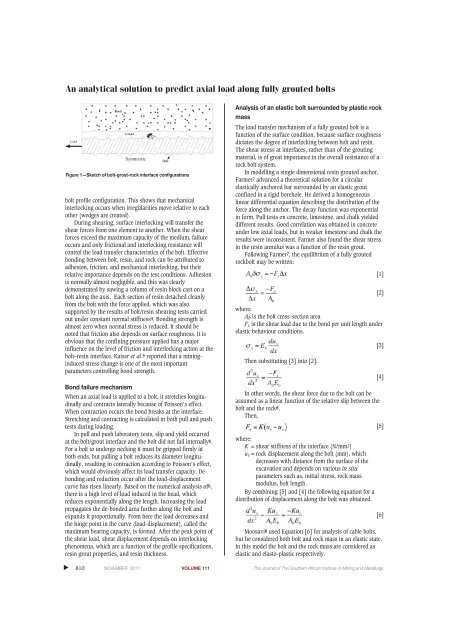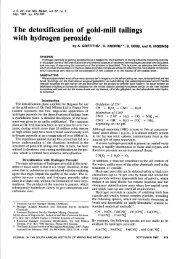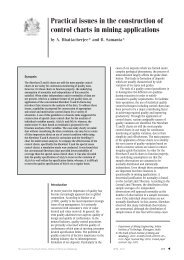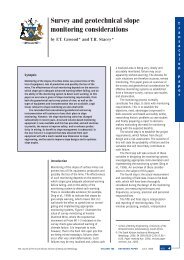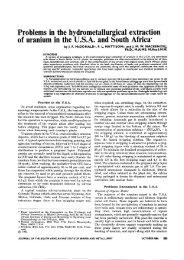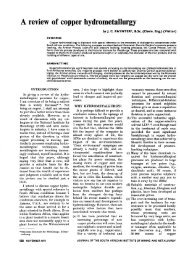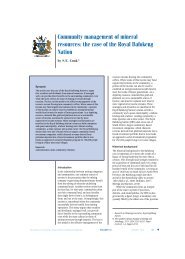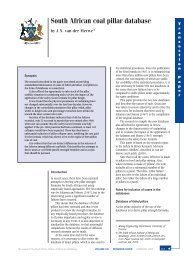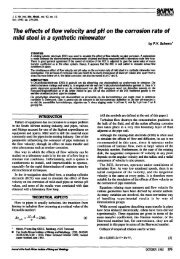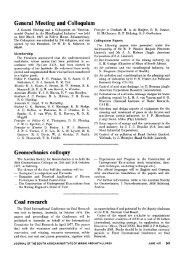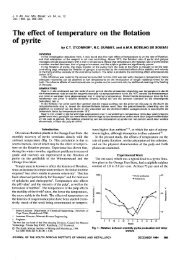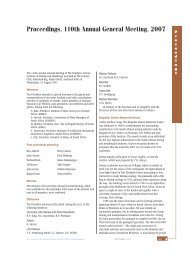Investigation of factors influencing the determination of ... - saimm
Investigation of factors influencing the determination of ... - saimm
Investigation of factors influencing the determination of ... - saimm
Create successful ePaper yourself
Turn your PDF publications into a flip-book with our unique Google optimized e-Paper software.
An analytical solution to predict axial load along fully grouted bolts<br />
Figure 1—Sketch <strong>of</strong> bolt-grout-rock interface configurations<br />
bolt pr<strong>of</strong>ile configuration. This shows that mechanical<br />
interlocking occurs when irregularities move relative to each<br />
o<strong>the</strong>r (wedges are created).<br />
During shearing, surface interlocking will transfer <strong>the</strong><br />
shear forces from one element to ano<strong>the</strong>r. When <strong>the</strong> shear<br />
forces exceed <strong>the</strong> maximum capacity <strong>of</strong> <strong>the</strong> medium, failure<br />
occurs and only frictional and interlocking resistance will<br />
control <strong>the</strong> load transfer characteristics <strong>of</strong> <strong>the</strong> bolt. Effective<br />
bonding between bolt, resin, and rock can be attributed to<br />
adhesion, friction, and mechanical interlocking, but <strong>the</strong>ir<br />
relative importance depends on <strong>the</strong> test conditions. Adhesion<br />
is normally almost negligible, and this was clearly<br />
demonstrated by sawing a column <strong>of</strong> resin block cast on a<br />
bolt along <strong>the</strong> axis. Each section <strong>of</strong> resin detached cleanly<br />
from <strong>the</strong> bolt with <strong>the</strong> force applied, which was also<br />
supported by <strong>the</strong> results <strong>of</strong> bolt/resin shearing tests carried<br />
out under constant normal stiffness4. Bonding strength is<br />
almost zero when normal stress is reduced. It should be<br />
noted that friction also depends on surface roughness. It is<br />
obvious that <strong>the</strong> confining pressure applied has a major<br />
influence on <strong>the</strong> level <strong>of</strong> friction and interlocking action at <strong>the</strong><br />
bolt–resin interface. Kaiser et al.5 reported that a mininginduced<br />
stress change is one <strong>of</strong> <strong>the</strong> most important<br />
parameters controlling bond strength.<br />
Bond failure mechanism<br />
When an axial load is applied to a bolt, it stretches longitudinally<br />
and contracts laterally because <strong>of</strong> Poisson’s effect.<br />
When contraction occurs <strong>the</strong> bond breaks at <strong>the</strong> interface.<br />
Stretching and contracting is calculated in both pull and push<br />
tests during loading.<br />
In pull and push laboratory tests, slip and yield occurred<br />
at <strong>the</strong> bolt/grout interface and <strong>the</strong> bolt did not fail internally6.<br />
For a bolt to undergo necking it must be gripped firmly at<br />
both ends, but pulling a bolt reduces its diameter longitudinally,<br />
resulting in contraction according to Poisson’s effect,<br />
which would obviously affect its load transfer capacity. Debonding<br />
and reduction occur after <strong>the</strong> load-displacement<br />
curve has risen linearly. Based on <strong>the</strong> numerical analysis <strong>of</strong>6,<br />
<strong>the</strong>re is a high level <strong>of</strong> load induced in <strong>the</strong> head, which<br />
reduces exponentially along <strong>the</strong> length. Increasing <strong>the</strong> load<br />
propagates <strong>the</strong> de-bonded area fur<strong>the</strong>r along <strong>the</strong> bolt and<br />
expands it proportionally. From here <strong>the</strong> load decreases and<br />
<strong>the</strong> hinge point in <strong>the</strong> curve (load-displacement), called <strong>the</strong><br />
maximum bearing capacity, is formed. After <strong>the</strong> peak point <strong>of</strong><br />
<strong>the</strong> shear load, shear displacement depends on interlocking<br />
phenomena, which are a function <strong>of</strong> <strong>the</strong> pr<strong>of</strong>ile specifications,<br />
resin grout properties, and resin thickness.<br />
Analysis <strong>of</strong> an elastic bolt surrounded by plastic rock<br />
mass<br />
The load transfer mechanism <strong>of</strong> a fully grouted bolt is a<br />
function <strong>of</strong> <strong>the</strong> surface condition, because surface roughness<br />
dictates <strong>the</strong> degree <strong>of</strong> interlocking between bolt and resin.<br />
The shear stress at interfaces, ra<strong>the</strong>r than <strong>of</strong> <strong>the</strong> grouting<br />
material, is <strong>of</strong> great importance in <strong>the</strong> overall resistance <strong>of</strong> a<br />
rock bolt system.<br />
In modelling a single dimensional resin grouted anchor,<br />
Farmer7 advanced a <strong>the</strong>oretical solution for a circular<br />
elastically anchored bar surrounded by an elastic grout<br />
confined in a rigid borehole. He derived a homogeneous<br />
linear differential equation describing <strong>the</strong> distribution <strong>of</strong> <strong>the</strong><br />
force along <strong>the</strong> anchor. The decay function was exponential<br />
in form. Pull tests on concrete, limestone, and chalk yielded<br />
different results. Good correlation was obtained in concrete<br />
under low axial loads, but in weaker limestone and chalk <strong>the</strong><br />
results were inconsistent. Farmer also found <strong>the</strong> shear stress<br />
in <strong>the</strong> resin annulus was a function <strong>of</strong> <strong>the</strong> resin grout.<br />
Following Farmer7, <strong>the</strong> equilibrium <strong>of</strong> a fully grouted<br />
rockbolt may be written:<br />
[1]<br />
[2]<br />
where;<br />
A b is <strong>the</strong> bolt cross-section area<br />
F x is <strong>the</strong> shear load due to <strong>the</strong> bond per unit length under<br />
elastic behaviour conditions.<br />
Then substituting [3] into [2]:<br />
In o<strong>the</strong>r words, <strong>the</strong> shear force due to <strong>the</strong> bolt can be<br />
assumed as a linear function <strong>of</strong> <strong>the</strong> relative slip between <strong>the</strong><br />
bolt and <strong>the</strong> rock8.<br />
Then,<br />
where:<br />
K = shear stiffness <strong>of</strong> <strong>the</strong> interface (N/mm2)<br />
u r = rock displacement along <strong>the</strong> bolt (mm), which<br />
decreases with distance from <strong>the</strong> surface <strong>of</strong> <strong>the</strong><br />
excavation and depends on various in situ<br />
parameters such as, initial stress, rock mass<br />
modulus, bolt length.<br />
By combining [5] and [4] <strong>the</strong> following equation for a<br />
distribution <strong>of</strong> displacement along <strong>the</strong> bolt was obtained.<br />
Moosavi8 used Equation [6] for analysis <strong>of</strong> cable bolts,<br />
but he considered both bolt and rock mass in an elastic state.<br />
In this model <strong>the</strong> bolt and <strong>the</strong> rock mass are considered as<br />
elastic and elasto-plastic respectively.<br />
[3]<br />
[4]<br />
[5]<br />
[6]<br />
▲<br />
810 NOVEMBER 2011 VOLUME 111 The Journal <strong>of</strong> The Sou<strong>the</strong>rn African Institute <strong>of</strong> Mining and Metallurgy


